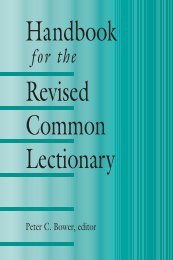000 Allen FMT (i-xxii) - The Presbyterian Leader
000 Allen FMT (i-xxii) - The Presbyterian Leader
000 Allen FMT (i-xxii) - The Presbyterian Leader
Create successful ePaper yourself
Turn your PDF publications into a flip-book with our unique Google optimized e-Paper software.
Proper 10 [15]/Year A 61<br />
first. <strong>The</strong> conflict was so intense that Rebekah expressed regret at the pregnancy<br />
(Gen. 25:22). God stated that Rebekah carried not only two infants<br />
but two nations, and, furthermore, by divine decree, the law of primogeniture<br />
was reversed in this case: the elder Esau would serve the younger Jacob<br />
(Gen. 25:23). 16 Israel and Edom are thus blood siblings and their tensions<br />
are sibling rivalry. In the background, God seeks to bless both.<br />
<strong>The</strong> names of the twins reveal their character. <strong>The</strong> first to emerge from<br />
the womb “came out red” with a hairy body. <strong>The</strong> word red (‘admoni) is a<br />
play on the word Edom (meaning red or ruddy) and probably refers to<br />
ruddy skin. <strong>The</strong> hairy quality anticipates Genesis 27:11–24. In some circles<br />
in antiquity, excessive body hair was regarded as crude, a detail that<br />
makes a social comment on Edomites (Gen. 25:25). 17 <strong>The</strong> younger comes<br />
from the womb holding to Esau’s heel, which the narrator associates with<br />
the name Jacob to mean that the younger twin sought to supplant the<br />
older. <strong>The</strong> picture of Jacob as supplanter and struggler become very<br />
important in Genesis 26–32.<br />
Esau was a hunter and Jacob a farmer (Gen. 25:27–28). Given the biblical<br />
editors’ aversion to killing (Gen. 1:26–28; 9:3–4), this is an implicit theological<br />
comment not only on the twins but on the communities descended<br />
from them. <strong>The</strong> Edomites and those like them are descended from a people<br />
with an inclination to violence, whereas Israel comes from stock that, at<br />
its best, lives in covenant with other elements of creation. However, the<br />
notion of covenant is not idealized, as we see in the next verses.<br />
In Genesis 25:29–34 the narrator exposes both twins as living short of<br />
divine purposes. Jacob was cooking a stew when a famished Esau appeared.<br />
Esau saw the stew simply as “red stuff,” a play on “Edom” (vv. 29–30), evidently<br />
not knowing, as a person living in community should, that the<br />
dish was lentil stew (v. 34). He was so undisciplined that he gave up his<br />
birthright to satisfy his immediate hunger. Jacob lived out the interpretation<br />
given him in 25:26 by seizing Esau’s weakened state to supplant the<br />
older twin. This pattern of behavior characterizes Jacob in the next chapters,<br />
and presages aspects of Israel’s later life when the community practices<br />
other forms of injustice.<br />
<strong>The</strong> biblical redactors use these associations to explain the irascible<br />
behavior of the Edomites in later centuries (e.g., Isa. 11:10–16; 34:1–17;<br />
Jer. 49:7–22; Ezek. 35:1–15; Amos 1:6–11; 2:1; Obad. 1–21; Mal. 1:2–4).<br />
However, some biblical writers preserve positive pictures of the Edomites.<br />
For example, the characters in the book of Job are Edomites (assuming<br />
Uz was in Edom), and the Deuteronomic theologians welcome Edomites<br />
(Deut. 23:8).




